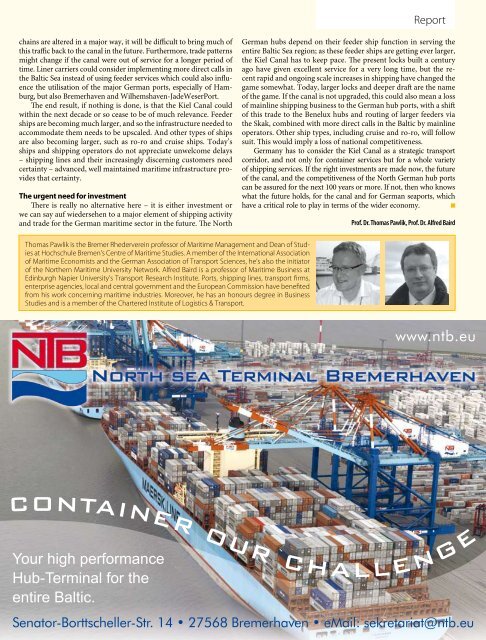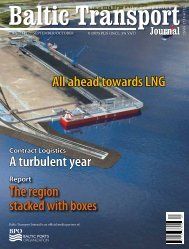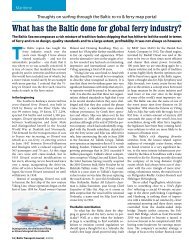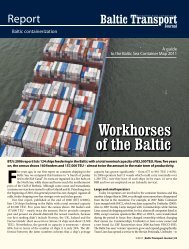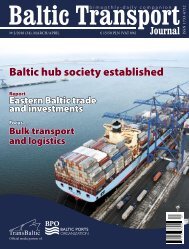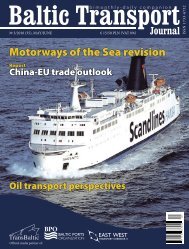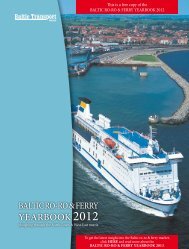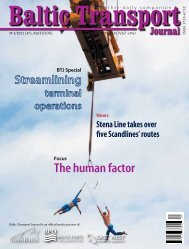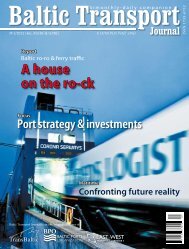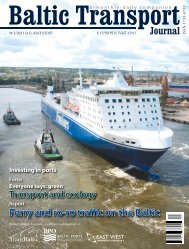ReportKiel CanalStrategic shortcut or bottleneck?“Ticking Bomb?” “Disaster?” If these and similar expressions are used in the public discussion on transportinfrastructure – in this case in an official statement of the Kiel Nautical Association in regard to the situation ofthe Kiel Canal – then it should be taken as a warning signal that something seems to be extremely wrong.This impression is enforced by the fact that in late August theGerman Shipowners’ Association (VDR), the German Shipbrokers’Association (ZVDS) and the Association of GermanSeaport Operators (ZDS) all signed a joint open letter to Dr.Peter Ramsauer, the German Federal Minister of Transport, Buildingand Urban Development (BMVBS) – urging the Federal Governmentto strengthen public investment in the modernization of the Kiel Canal,especially to start with the construction of a fifth lock chamber inBrunsbüttel at the westerly end of the canal.Kiel Canal trafficLet’s look at the numbers and trends before deliberating on the needfor infrastructure investment. According to the Waterways and ShippingAdministration of the Federal Government, being responsible forthe management and maintenance of the Kiel Canal, in 2010 the canalhosted an average of 87 ships per day – a number which still qualifiesfor top of the league of artificial seaways. In other words it is a very successfulwaterway. In comparison to the passage via the Skak, a voyagebetween West-European ports and the mid-point of the <strong>Baltic</strong> via theapprox. 100 km long Kiel Canal is approximately 180 NM shorter. Thisdistance saving in turn leads to a large reduction in ship fuel consumptionand hence less emissions of greenhouse gases; so the canal offers apositive environmental benefit as well as a ship operating cost and timeadvantage to the benefit of users. The following figure shows canal trafficindex numbers for the period between 2000 and 2010 concerningthe number of ships, total cargo volume and total gross tonnage.Fig. 1. Kiel Canal traffic (2000 = 100)Source of data: www.kiel-canal.orgBetween 2000 and 2008 the number of ships transiting the canalincreased almost consistently (with the exception of 2006) from38,377 p.a. in 2000 to 42,811 p.a. in 2008. Due to the deployment oflarger vessels, the increase in total cargo (2000: 57,861,599 tonnes; 2008:105,869,136 tonnes) and total gross tonnage (2000: 100,750,615 tonnes;2008: 175,159,970 tonnes) was even bigger. The worldwide shippingcrisis in 2009, however, led to a dramatic slump in canal traffic. Onereason for this was, in addition to the overall decrease in cargo volumes,34 | <strong>Baltic</strong> Transport Journal | 5/<strong>2011</strong>a shift in some <strong>Baltic</strong> Sea feeder traffic to and from Hamburg throughthe Kiel Canal to, inter alia, the Port of Rotterdam as low charter rates,combined with low bunker costs made such feeder services economicallymore viable. Since 2010, however, canal traffic has increased againand it is expected that the <strong>2011</strong> cargo figures might be close at the 2008record level. Thus, it should now be expected that, given expectationsof growth in <strong>Baltic</strong> trade, demand for shipping to use the canal willcontinue to increase over the long term.Preparing the Kiel Canal for the futureOnly a few years after the opening of the then Kaiser-Wilhelm-Kanalin 1895, the first major expansion took place. Between1907 and 1914 the canal was widened to enable the passageof a new generation of big battleships. As early as 1906 theFirst Lord of the British Admiralty, John Arbuthnot Fisher, predictedthat in 1914, when the canal expansion with new locksat both ends in Kiel-Holtenau and in Brunsbüttel were due tobe completed, a war between Britain and Germany would breakout. Like all of the world’s major canal systems (e.g. Suez, Panama,etc.), such infrastructure was and still is of major strategicsignificance, militarily as well as economic, for the nations andregions most directly concerned. So we should be clear – the KielCanal is of strategic significance, and thankfully today more interms of its important economic function.Today, almost 100 years after their erection most people still usethe term “new” for the locks from the beginning of the last century.But it has become more and more obvious during the recentpast that neither the 19 th century “old locks” nor the “new locks” arereliable enough to guarantee smooth canal operations. Repeatedly,breakdowns and repair works at the locks force vessels to queue upand wait for their lock transit in Brunsbüttel. This should not be thatsurprising – the locks are, after all, basically 100-year old infrastructure.The modernization of the Kiel Canal has been included as oneof the first priority projects in the Federal Transport InfrastructurePlan. Thus, initially it was intended to start with the newbuildingof a fifth lock chamber in Brunsbüttel already in 2010 – with totalcosts estimated to amount to EUR 350 mln. But, in light of thetight budgets, in August <strong>2011</strong> the BMVBS announced it was goingto postpone the newbuilding and to start instead with the rejuvenationof the existing locks (cost estimates: EUR 85 mln per lock). Theimprovement of the lock situation at Brunsbüttel is only one part ofa number of measures to prepare the canal for the future: a new lockin Kiel-Holtenau, the deepening of the canal and the enlargementof the eastern part of the canal are also on the agenda – all in all theinvestment will cost EUR 1.25 bln.Fear of a total breakdownA number of experts meanwhile fear a total breakdown of thecanal if counter-measures are not implemented without delay. In aworst case scenario job losses could be expected as well as a shift incargo flows from waterway to road; if the latter happens, and supply
Reportchains are altered in a major way, it will be difficult to bring much ofthis traffic back to the canal in the future. Furthermore, trade patternsmight change if the canal were out of service for a longer period oftime. Liner carriers could consider implementing more direct calls inthe <strong>Baltic</strong> Sea instead of using feeder services which could also influencethe utilisation of the major German ports, especially of Hamburg,but also Bremerhaven and Wilhemshaven-JadeWeserPort.The end result, if nothing is done, is that the Kiel Canal couldwithin the next decade or so cease to be of much relevance. Feederships are becoming much larger, and so the infrastructure needed toaccommodate them needs to be upscaled. And other types of shipsare also becoming larger, such as ro-ro and cruise ships. Today’sships and shipping operators do not appreciate unwelcome delays– shipping lines and their increasingly discerning customers needcertainty – advanced, well maintained maritime infrastructure providesthat certainty.The urgent need for investmentThere is really no alternative here – it is either investment orwe can say auf wiedersehen to a major element of shipping activityand trade for the German maritime sector in the future. The NorthGerman hubs depend on their feeder ship function in serving theentire <strong>Baltic</strong> Sea region; as these feeder ships are getting ever larger,the Kiel Canal has to keep pace. The present locks built a centuryago have given excellent service for a very long time, but the recentrapid and ongoing scale increases in shipping have changed thegame somewhat. Today, larger locks and deeper draft are the nameof the game. If the canal is not upgraded, this could also mean a lossof mainline shipping business to the German hub ports, with a shiftof this trade to the Benelux hubs and routing of larger feeders viathe Skak, combined with more direct calls in the <strong>Baltic</strong> by mainlineoperators. Other ship types, including cruise and ro-ro, will followsuit. This would imply a loss of national competitiveness.Germany has to consider the Kiel Canal as a strategic transportcorridor, and not only for container services but for a whole varietyof shipping services. If the right investments are made now, the futureof the canal, and the competitiveness of the North German hub portscan be assured for the next 100 years or more. If not, then who knowswhat the future holds, for the canal and for German seaports, whichhave a critical role to play in terms of the wider economy. Prof. Dr. Thomas Pawlik, Prof. Dr. Alfred BairdThomas Pawlik is the Bremer Rhederverein professor of Maritime Management and Dean of Studiesat Hochschule Bremen’s Centre of Maritime Studies. A member of the International Associationof Maritime Economists and the German Association of Transport Sciences, he’s also the initiatorof the Northern Maritime University Network. Alfred Baird is a professor of Maritime Business atEdinburgh Napier University’s Transport Research Institute. Ports, shipping lines, transport firms,enterprise agencies, local and central government and the European Commission have benefitedfrom his work concerning maritime industries. Moreover, he has an honours degree in BusinessStudies and is a member of the Chartered Institute of Logistics & Transport.5/<strong>2011</strong> | <strong>Baltic</strong> Transport Journal | 35


